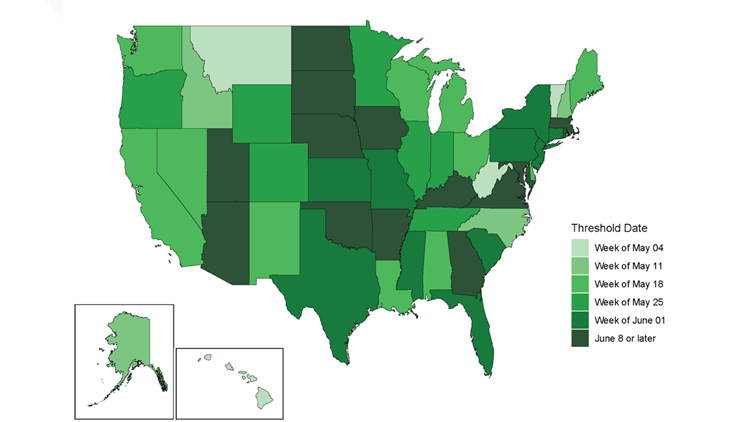Oregon could consider relaxing social distancing measures by May 25, a week later than other West Coast states, according to first-of-their-kind projections from University of Washington researchers.
The dates are intended as a guide, said Christopher Murray, the director of UW’s Institute for Health Metrics and Evaluation, and are likely to change.
“If I were a governor of a state, I would certainly not make a decision based just on our model,” Murray said. Leaders should also rely on the number of new deaths, hospitalizations and positive cases, he said.
Oregon Gov. Kate Brown on Tuesday released a framework for reopening the state but didn’t set any dates, saying she would gradually reopen the state’s economy using an approach rooted in science. She said she wants to see a declining growth rate of active cases, sufficient personal protective equipment, surge capacity in hospitals and increased capacity for testing and tracking positive cases.
Asked about the IHME estimate, Brown’s spokesman reiterated what the governor said earlier this week -- that Oregon’s reopening will be contingent on slowing the spread of the coronavirus.
“Timelines for reopening communities will be driven by solid data on the spread of COVID-19, county by county as necessary,” said her spokesman, Charles Boyle.
The researchers’ May 25 projection assumes that by then Oregon will have implemented a strategy to test, track and isolate coronavirus carriers and that a tiny number of active cases will remain – 1 in every 1 million residents.
Oregon today doesn’t yet have a plan for testing, tracking and isolating, though it’s being drafted. But the state is nowhere near the 1-in-a-million target.
State health officials are using estimates that show there could currently be about 7,600 active infections in Oregon – roughly 1,900 per million people. Less than a quarter have been found, the result of Oregon’s lagging test capacity.
The estimates being used in Oregon project more than 2,000 infections will remain by May 22, far higher than 1-in-a-million.
The UW institute’s modeling has increasingly been criticized by scientists, who say its widely cited projections have been flawed and aren’t accurate enough to use in decision-making.
“This appearance of certainty is seductive when the world is desperate to know what lies ahead,” a group of researchers wrote Tuesday in the Annals of Internal Medicine. “However, the underlying data and statistical model must be interpreted cautiously.”
The institute’s initial forecasts for Oregon were more dire than what unfolded, though Murray said frequent revisions have been driven by far better, nuanced data on the effectiveness of social distancing. The institute now projects Oregon will peak in two days, echoing the model the state is using that shows cases are plateauing.
But the institute shows a sharp drop-off, while the model Oregon is using projects positive cases remaining elevated for weeks to come.
Murray said deaths in the United States may have peaked two days ago, but that the death toll could still be as high as 60,000 people, down from 68,000 estimated earlier in the week.
The suggested date comes as a nationwide battle has begun unfolding about when to ease unprecedented social distancing measures that have left millions unemployed while successfully driving down the transmission of a virus that has killed more than 34,000 in the United States, including 70 in Oregon.
Patrick Allen, director of the Oregon Health Authority, said the state was likely to see infection and death rates begin to drop in coming weeks. “But we need to know we can keep a lid on new infections before we can fully re-open the state economy and return to normal life,” Allen said.
The authority is drafting plans for reopening sectors of the economy. Brown told OPB’s Think Out Loud Friday that Oregon was being held back by its inadequate testing capacity.
The state is currently testing about 9,000 a week and is still encouraging doctors not to test those with mild symptoms. Brown told OPB that capacity should reach a target of about 15,000 a week. Other public health experts have said states should be able to test about 1% of their population weekly. In Oregon, that would be more than 40,000 a week.
Brown demurred when asked which sectors may reopen first.
— Rob Davis
503.294.7657; @robwdavis
This article was originally published by The Oregonian/OregonLive, one of more than a dozen news organizations throughout the state sharing their coverage of the novel coronavirus outbreak to help inform Oregonians about this evolving health issue.



